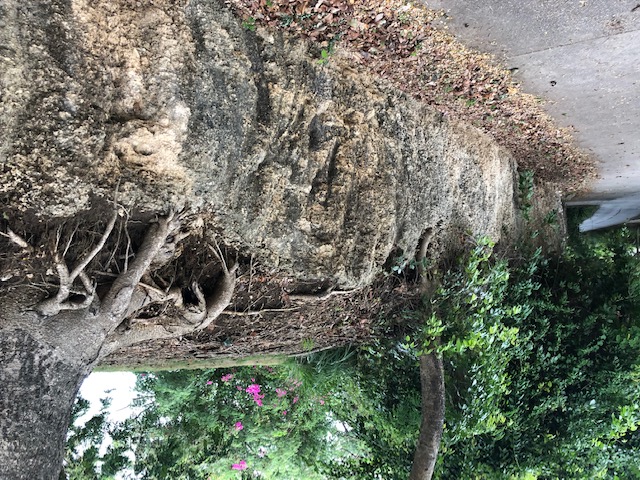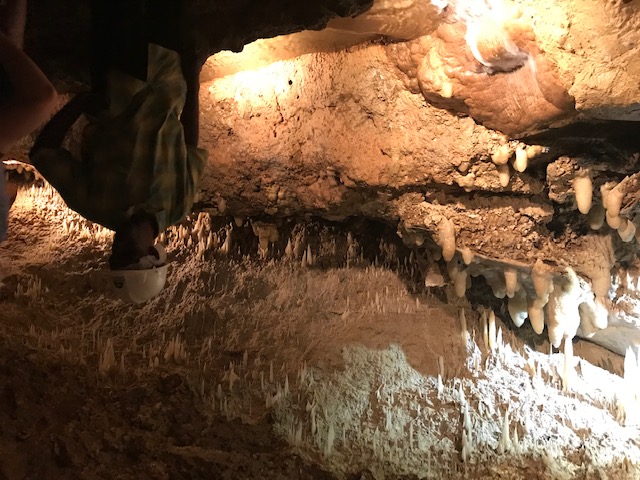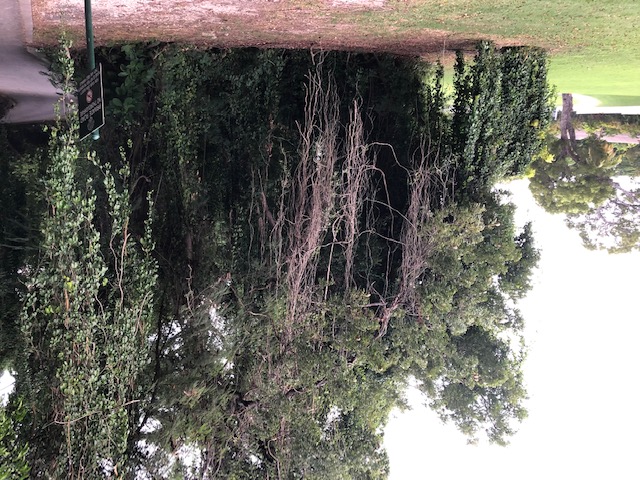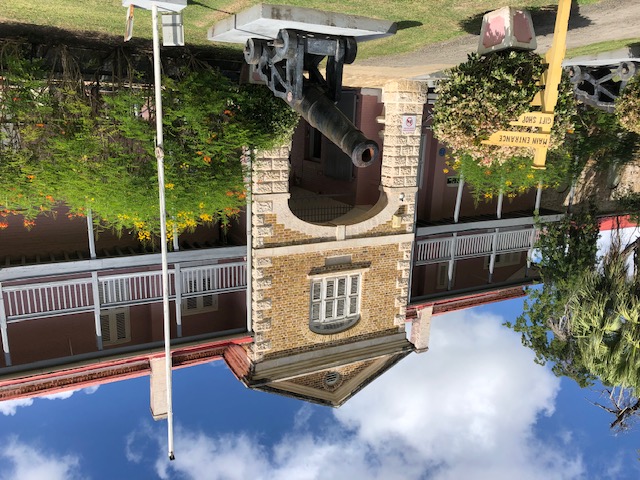Barbados: A Walk through History (Part 2)
Section 1 Early History of the Coral Island

(Limestone formation common in Barbado)
I noticed something while visiting many different places in Barbados, which is whenever the earth’s layer is revealed on steep slopes or roads cut through hills that most times white, rough rock can be seen.
This is because Barbados is an island composed of limestone mainly formed by coral reefs which were uplifted when crustal movements occurred in ancient times. If you look closely at the surface of the bedrock that is exposed, there are cases where you can clearly see the traces of coral left on the rock.
Barbados belongs to the Lesser Antilles, which are lined up in what can be described as an arc in the southeastern Caribbean Sea. Neighboring islands such as St. Vincent and St. Lucia are all volcanic islands, and their red-brownish soil originating from lava and volcanic ash is easy to spot. However, I later learned that the origin of Barbados, jutting out a step east towards the Atlantic Ocean, is different than its fellow neighbors.
Thus, the island’s ground is stable, and I have never heard of a mudslide occurring due to the occasional heavy rains. There are a number of limestone caves which are common in limestone-rich areas, and one in particular that has become a tourist spot-Harrison’s Cave-the largest cave and located in the center of the island, is by far larger than the limestone caves one can find in Japan. A guide will take you on a tour of the cave on a small tram, exploring the inside for about an hour, and is worth the visit.

(Inside Harrison’s Cave)
The First People to Arrive
It is uncertain when people started living on this island that rose up from the coral reefs, but according to research from archaeologists, evidence was found of the Barrancoid people living on the island around 2,000 years ago.
Going back even further to the Ice Age, what is the current Bering Strait was a continuous land of what is now between the Eurasia and North American continents. Humans took this passageway to cross from Eurasia to North America, which took place according to various theories more than 20,000 years ago. Later on, Native Americans (Indians, Indio) made their way to North America, traveling to South America and to the Caribbean islands. The Barrancoid people were part of the group of humans moving and settling across the American continents.
The Barrancoid people were living on the island until the beginning of the 7th century, but they subsequently disappeared after.
Roughly 200 years after, the Arawak people made their way from the South American continent via Trinidad Island by canoe to the island of Barbados. The Arawak survived on fish they caught in the sea, and raised crops like cassava and corn by slash-and-burn agriculture. Their elaborate earthware and knives made from conch shells have been excavated (Note 1).
The Arawak lived in peace for approximately 400 years, but around the 13th century the Carib people came upon the island. The Carib were warlike people, using arrowheads made out of shells of sea turtles and fish bones; the Arawak were driven out in no time by the Carib.
The Carib settled across the Lesser Antilles; several times more the amount of earthware characteristic to the Carib people have been found on Barbados island compared to other islands, leading archaeologists to believe that Barbados was the center of the Carib civilization in the eastern Caribbean region. It is said that the Carib, who were the main inhabitants of the region until the Europeans arrived later on, were a cannibalistic people. There are accounts of a Spanish ship that in 1564 ran aground on the island of Dominica, and the crew were killed and eaten by the Carib. Another account details an incident 40 years later where a French ship met the same fate on the island of St. Vincent - that’s what certain books say. There are even theories that the word “cannibalism” comes from the word “Carib”, albeit this theory is only plausible and not certain. Yet if everyone of those poor sailors onboard the ship was killed and eaten, then how these accounts were recorded is a mystery to me...
Be that as it may, the Spanish confirmed the existence of the Carib on Barbados in the beginning of the 1500s; however, in 1536 when the Portuguese ship lead by Pedro A Campos arrived on the island, the Carib people had disappeared and the island was uninhabited. It is believed that the reasons for their disappearance are the infectious diseases such as smallpox, the measles, the influenza etc. that the Europeans brought with them and spread quickly among the Carib, who had no immunity against them; another factor is thought to be the forceful use of the Carib people as workers on Spanish Hispaniola (current island of Haiti and the Dominican Republic), taken from Barbados.
By the way, the name “Barbados” was named by the aforementioned explorer Pedro A Campos and other Portuguese; it comes from the Portuguese “os barbudos”, meaning “bearded men”. It is said this name comes from the fact that the island was full of trees covered in vines, making one think it looked like a bearded man. “Barbados” can be directly translated as “Bearded Island”.

(It is possible that the Portuguese saw a tree such as this one, covered in vines like a beard, and decided to name the island such.)
From the end of the 15th century, Europeans started exploring the world with their developed art of navigation backed up by improved shipbuilding technology and introduction of the compass. They were after Asian products, in particular pepper and other spices which had become indispensable items in Europe. They had previously relied on trade with the Ottoman Empire and Venetian merchants who acted as middlemen for trade in the Mediterranean; however, the west European countries faced a demand to pioneer new routes in order to procure these products cheaply through direct trade with Asia. This is the beginning of the European “Age of Discovery”.
The leaders of the “Age of Discovery” were Portugal and Spain.
Portugal explored southward, and made land in Western Africa as soon as the first half of the 15th century. In 1486 Bartolomeu Dias discovered the southernmost point of Africa, the Cape of Good Hope, allowing for the possibility to reach India by sailing around the tip of Africa (Note 2).
Competing with Portugal was Spain, who attempted to take the opposite course. Maps at that time did not have the North and South American continents nor the Caribbean Sea on them, so explorers thought that if they continued West they would end up in Asia.
Queen Isabella of Spain supported Christopher Columbus, who was from Genova, Italy, and sent him off on his voyage in search of Asia taking a western route. He left Spain in August 1492 on the ship “Santa Maria”, and after two months he made landfall. It is currently thought that he landed on San Salvador Island in the Bahamas (previously called Watling’s Island). Columbus had landed in the Caribbean.
Columbus crossed the Atlantic four times between the years 1492 and 1504, and he is known for “discovering” the North America continent. It is well-known, however, that he was convinced that he had landed in India until the very end (Note 3). This is the reason why islands in the Caribbean are called “West Indies”, and this name is still in use to this day.
Around the time of the “discovery” of the new continent, the territorial battle between Spain and Portugal in the Western Hemisphere was heating up. In order to try and settle the conflict between the two countries, in 1494 the Roman Pope Alexander VI helped facilitate the Treaty of Tordesillas. This treaty allotted the lands “discovered” offshore west of Africa’s west coast down the meridian to Spain, and the lands offshore east to Portugal (despite the fact that indigenous peoples were already living on these lands, the treaty was signed without their consideration. Such inclinations of the Europeans continue into the following centuries). This is the reason why Spain established colonies in the Americas, while Portugal’s colonies were in the African continent (Note 4).
The above is the reason how the Caribbean Sea became roped off by Spain for a period of time.
Lesser Antilles was a Bonus
The area that Spain solidified the ground in the Caribbean was not the Lesser Antilles, which includes Barbados, but the Greater Antilles islands to the north west, comprised of the large islands such as Hispaniola, Cuba, Jamaica, and Puerto Rico. The Spanish mined silver, grew tobacco, pepper, and tropical fruit on plantations, with sugar cane eventually becoming a crucial crop.
The Spanish considered the small islands of the Lesser Antilles as just an extra add-on and did not hold much interest, as they were already receiving enough profit from the larger lands of the Greater Antilles. It might have been that the Spanish did not have the time nor think it would be profitable enough to establish a new settlement in such small islands as Barbados at that time. The Spanish only dropped anchor there to refill their fresh water reserves, and hunted the remaining Arawak and Carib people to bring back as labor force on the Greater Antilles, all without permanently establishing a Spanish settlement. A good number of the indigenous people who were brought died very soon from harsh working conditions and contagious diseases passed on by the Europeans; in time slaves from Africa were brought in to replace them. At the time, the Portuguese were in control of the Atlantic slave trade, as they had in their power slave-export bases on the West African coast.
A Rise of Emerging Powers
In the later half of the 16th century, a change occurred in the power balance between the European nations as their maritime expeditions continued to advance. Newcomers to the scene included France, the Netherlands, and England, casting a shadow over the hegemony that Portugal and Spain once held.
Portugal, a marine power who at one point was a prosperous nation, was annexed by Spain in 1580 after Portuguese King Sebastian I died at war in Africa, bringing an end to the royal succession (Portugal gained back its independence in 1640).
France, a rival to the Spanish kingdom, had been occupied by the internal Wars of Religion (1562-1598), which was brought to an end by King Henry IV, the first of the Bourbon dynasty, and who will later build the base for France’s prosperity.
The Netherlands, a Spanish-dependent territory, had been in a long-lasting war for independence with Spain (1567-1609), and used intermediary trade as its linchpin to quickly advance its maritime endeavors.
On the other hand, under the rule of Queen Elizabeth I of the Tudor dynasty, was approaching its heyday of absolutism with established influence of the Anglican Church. On the national front, the development of the wool industry led to an increase in overseas advancement. This period was a lively time on the cultural front as well, with Shakespeare and other famous figures active in this time. In 1588 the “invincible Spanish Armada” planned an invasion into England which the English navy won, setting the scene for the decline of the Spanish hegemony at sea.
Among the many people who fought against the Spanish Armada when they attacked England is a vice admiral in the English navy named Francis Drake. The title “vice admiral” may sound nice, but this man known as “Captain Drake” was actually a pirate who, at the tender age of ten, became a sailor and spent a lengthy amount of time in the West Indies taking part in the slave trade while simultaneously rampaging and pillaging Spanish ships and settlements. Captain Drake was one of many privateers who were rampant at this time; with the “permission” of the monarchy, privateers openly attacked enemy nations’ ships in the Atlantic and Caribbean waters. The privateers paid out money from the pillaged goods to the monarchy, which acted as a substantial source of financial income for the royal throne. This is how England rose up as a new emerging power-by raking in riches gained from violent exploits in the name of the Crown.
Captain Drake, who was also the first Englishman to complete a trip around the world, was knighted by Queen Elizabeth I to become Sir Drake in recognition of his many feats. It was not until well after that we see the English upperclass elegant and refined; at the time no matter if one was an aristocrat or high-ranking military, they were a bunch of sturdy gangsters (Note 5).
Among them was a man named Thomas Warner, who served as a captain in the guards of James I (the first king of the Stuart dynasty after the death of Elizabeth I). In 1620 he was stationed in Guyana, England’s South American colony, but three years later he moved north by boat and landed on St. Kitts in the Lesser Antilles. He subsequently moved with his family and followers to the island and established a tobacco plantation. St. Kitts became the first English colony in the Caribbean, and a few years later Warner, along with his subordinates, tied up with the French who came along afterward to commit massacre against the indigenous Carinago people (a branch of the Carib people), killing around 2,000 of them.
*********************************************
These emerging powers, who, ignoring the then existing international order - the Treaty of Tordesillas which had set the sphere of influence between Spain and Portugal 100 years ago -, continued to compete in Caribbean waters. Many trade ships filled with wealth from the colonies and slave ships packed with Black people abducted from Africa were sailing all around the Caribbean, and they were targets of pirates.The Caribbean Sea turned out to be a lawless place where anything was possible.
During all of this, Barbados was taken possession by England.
(To be continued in Section 2: English Colonial Business)

(Building housing the Barbados Museum & Historical Society. This building was the English military prison in the colonial time)
(Note 2) Later on, Vasco da Gama rounded the Cape of Good Hope, crossing the Indian Ocean and making land on the west coast of India in 1498.
(Note 3) Eventually the Italian geographer and explorer Amerigo Vespucci brought to light that this newly discovered continent is in fact separate from the Asian continent, and the name “America” will be given after Amerigo Vespucci.
(Note 4) Portuguese explorer Pedro Alvares Cabral washed ashore on Brazil in the year 1500, thus becoming the only Portuguese colony in otherwise Spanish-controlled South America. Brazil started the use of slave labor for sugar cane production as early as the 16th century.
(Note 5) In the first place, Elizabeth I herself executed her relative and the former Queen of Scotland, Mary Stuart, who was supposed to be a challenger to the legitimacy of Elizabeth’s right to the throne of England. This pitted her against Philip II of Spain, whose intervention led to the Battle of Armada. Interestingly enough, however, after Elizabeth I died heirless, James I (Mary Stuart’s son and founder of the Stuart Dynasty) took the throne of England. The current British royal family are descended from him.
(This column reflects the personal opinions of the author and not the opinions of the Ministry of Foreign Affairs of Japan)
WHAT'S NEW
- 2024.12.4 UPDATE
PROJECTS
"Barbados A Walk Through History Part 14"
- 2024.9.17 UPDATE
PROJECTS
"Barbados A Walk Through History Part 13"
- 2024.7.30 UPDATE
EVENTS
"408th Lecture Meeting Regarding Global Issues"
- 2024.7.23 UPDATE
PROJECTS
"Barbados A Walk Through History Part 12"
- 2024.7.9 UPDATE
ABOUT
"GREETINGS FROM THE PRESIDENT JULY 2024"
- 2024.7.4 UPDATE
EVENTS
"APIC Supports 2024 Japanese Speech Contest in Jamaica"
- 2024.6.27 UPDATE
EVENTS
"407th Lecture Meeting Regarding Global Issues"
- 2024.5.21 UPDATE
EVENTS
"406th Lecture Meeting Regarding Global Issues"
- 2024.5.14 UPDATE
EVENTS
"405th Lecture Meeting Regarding Global Issues"
- 2024.4.2 UPDATE
PROJECTS
"Water Tanks Donated to Island of Wonei, Chuuk, FSM"




